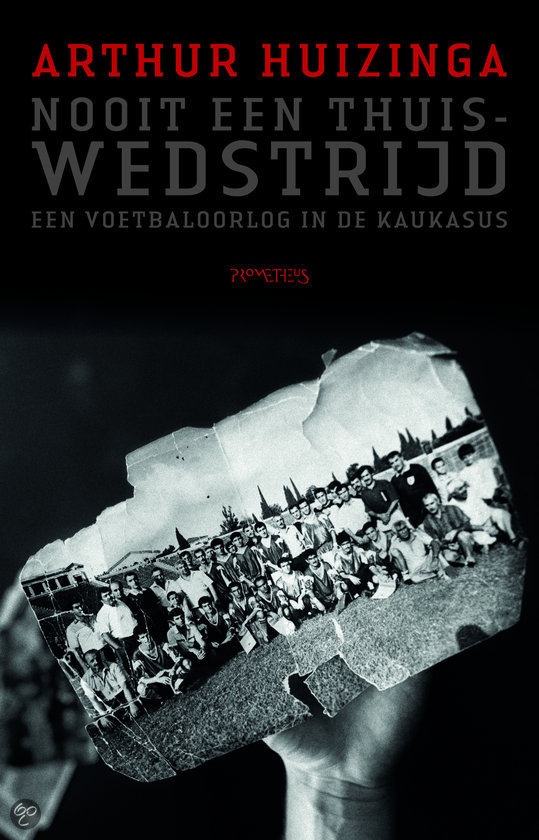15 November 2012
Book review: Nooit een thuiswedstrijd by Arthur Huizinga
 Nooit een thuiswedstrijd — Een voetbaloorlog in de Kaukasus
Nooit een thuiswedstrijd — Een voetbaloorlog in de Kaukasus
Arthur Huizinga
Prometheus, Amsterdam
June 2012
288 pages
ISBN: 978-90-446-1665-1
When Armenian troops conquered the town of Ağdam in 1993, its entire population (some 30000 people) was forced to flee. Nooit een thuiswedstrijd is about the exiled football club FK Qarabağ Ağdam and its people, and by extension, the entire refugee community.
Arthur Huizinga has chosen to write the book in a highly personal style. As a result, the text feels at times almost like a travelogue, and in the first half of the book there are some passages where somewhat confusingly, Huizinga adopts the perspective of some of the characters during events he did not himself attend, but overall this was clearly the right approach to the subject matter — this is a book about people first and political history second.
That said, this choice carries with it the risk that the portrayal of the political context suffers, and to be sure, the book does contain some errors. Some of these are ultimately inconsequential, such as the claim that in 1995, Robert Kocharyan won a great election victory over incumbent President of Armenia Levon Ter-Petrosyan, whereas in reality, the two never competed against each other. (In fact, Ter-Petrosyan won the parliamentary election of 1995 and was re-elected President in 1996. Only in 1998 was he forced to resign under pressure from Kocharyan, by then Prime Minister, who succeeded him as President in the subsequent election.)
There is a more regrettable omission in the second chapter, where Huizinga points out that when the Autonomous Oblast of Nagorno Karabakh was formed in 1923, the town of Shushi, the only major town with an Azeri majority, was not chosen as its capital, despite being the cultural centre of Nagorno Karabakh. In itself, this is true, but the author fails to mention that Shushi only had an Azeri majority due to the pogrom in 1920 that resulted in the flight of virtually all of its Armenian inhabitants and the death of hundreds, if not thousands. If for no other reason, Shushi was not suited to be made capital in 1923 because it lay completely in ruins. This traumatic event is likewise absent from the chronology at the end of the book, as is any mention of the Armenian Genocide.
The second chapter also gives rise to an inconsistency within the text, when it introduces the football club Karabakh Stepanakert. It and Qarabağ Ağdam did not compete often in Soviet times, but could still be considered traditional rivals. Huizinga then mistakenly claims that since Karabakh Stepanakert disappeared after the war in Nagorno Karabakh, no more derbies can be played. The error is especially surprising since Huizinga later visits the team (now called Lernayin Artsakh Stepanakert) and its people, whose fortunes in some ways mirror those of Qarabağ Ağdam (first exile to Yerevan, later return to Stepanakert). Huizinga also mistakenly implies that professional football is impossible in Nagorno Karabakh because it is disallowed by FIFA, whereas of course FIFA is a private company that can only impose its will on its member associations — Nagorno Karabakh now in fact has its own competition.
Finally, one more error that is again more or less inconsequential, but too unfortunate not to mention here. When discussing the temple at Suraxanı, Huizinga caricatures members of the world religion of Zoroastrianism (which has its origins in Persia) as "adherents of the cult of Zoroaster, a sect from India that lets itself be enraptured by fire". In fact, the current temple complex is not Zoroastrian at all, but Hindu, which may have added to Huizinga's confusion.
Lest these observations give off to the impression that Nooit een thuiswedstrijd is poorly researched, let me quickly add that, luckily, they are the exception. More generally, it is important to note that Nooit een thuiswedstrijd is not a naive book. Despite mostly portraying Azeri perspectives, it manages to provide a fair characterisation of the Nagorno Karabakh conflict, focusing on the lot of the refugees, and certainly not glossing over the dubious commitment of the Azerbaijani government.
The book is not overly long, and it covers all the ground it needs to. The one matter that could have received more explicit attention is the relation between Ağdam and Nagorno Karabakh proper. Despite the historical links between them, and the fact that the government of Nagorno Karabakh has formally annexed Ağdam, it was not part of the Nagorno Karabakh Autonomous Oblast in Soviet Times, and it seems clear that Nagorno Karabakh will give up Ağdam in case a peace agreement is reached. This means that the refugees may rightly hope that they can one day return to their town. But also that the more years pass before a peace agreement is reached, the less of Ağdam's pre-war society can be salvaged. And this in turn raises the question whether the former inhabitants of Ağdam would be willing to give up Nagorno Karabakh proper if it means they can return to their homes sooner rather than later. This is a sensitive question, but it would nevertheless have been interesting to hear the opinions of some of the characters in the book on this matter.
That this question arises is a tribute to the fact that Nooit een thuiswedstrijd succeeds in giving a voice to the refugees of Ağdam — the book's greatest feat. The choice of its subject, FK Qarabağ Ağdam, provides the necessary catalyst for this, and Huizinga manages to tell a great story about both the conflict and about football. Enhanced by its narrative, its not always chronological structure, both the fortunes of FK Qarabağ Ağdam (in Azerbaijan and in Europe) and its people and Huizinga's attempts to reach Ağdam are varyingly moving, funny and genuinely exciting, and are best left for the reader themself to explore.